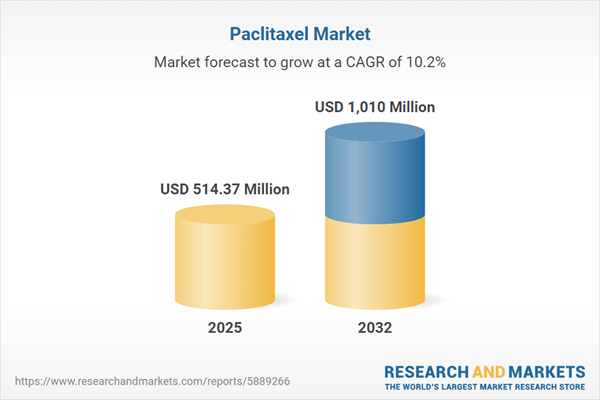Speak directly to the analyst to clarify any post sales queries you may have.
The global paclitaxel market is experiencing fundamental change as new regulatory policies, clinical advancements, and supply chain adaptations reshape industry dynamics. Senior decision-makers need precise, up-to-date insights to adapt strategies and drive organizational growth while navigating changing oncology care standards and heightened competitive pressure.
Paclitaxel Market Snapshot
In 2024, the paclitaxel market is valued at USD 466.21 million, with a compound annual growth rate (CAGR) of 10.20%. Forecasts project the market to reach USD 514.37 million by 2025 and exceed USD 1.01 billion by 2032. Accelerated uptake is attributed to broader incorporation of paclitaxel across current oncology protocols, supported by ongoing research innovation and evolving clinical care pathways. Regulatory shifts and expanded use in established and emerging economies continue to drive adoption, shaping business opportunities and challenges. Senior stakeholders find that compliance and reimbursement regulations are increasingly central to success, fundamentally impacting long-term strategies for market access.
Scope & Segmentation of the Paclitaxel Market
This report arms executive teams with segment-level intelligence to enable targeted decision-making and effective resource deployment. The comprehensive segmentation assessment includes:
- Formulation Types: Liposome-encapsulated, nanoparticle albumin-bound, conventional, and polymeric micelle formulations, providing strategic insight into delivery technologies and generic competition.
- Application Spectrum: Oncology uses in breast, lung, and ovarian cancer, enabling companies to align product pipelines with key therapy areas and current clinical needs.
- End User Sectors: Hospitals and specialized cancer clinics, giving clarity on procurement processes, utilization drivers, and operational opportunities for tailored service models.
- Distribution Channels: Direct-to-hospital supply, retail pharmacy networks, and digital pharmacy platforms, clarifying the evolving landscape of access and the effect on market penetration.
- Administration Routes: Intravenous techniques, encompassing both central and peripheral infusion approaches, informing clinical workflow adjustments and resource allocation.
- Geographic Reach: Americas, Europe, Middle East & Africa, Asia-Pacific, with specific attention to the United States, Canada, Brazil, Germany, China, and India, supporting regional go-to-market planning and investment focus.
- Key Company Profiles: Leading organizations analyzed include Pfizer Inc., Sandoz International GmbH, Sun Pharmaceutical Industries Ltd., Teva, Dr. Reddy’s, Cipla, Viatris, Fresenius Kabi AG, Hikma, and Bristol-Myers Squibb, supporting benchmarking and collaboration strategies.
Paclitaxel Market: Key Takeaways for Executives
- Next-generation delivery systems, such as nanoparticle and liposomal formulations, are elevating dosing precision and enhancing therapeutic effectiveness, which will impact competitive positioning and future business models.
- Meeting evolving regulatory standards now requires advanced supply chain visibility and strong safety compliance frameworks, both essential for reliable market access and operational continuity.
- Broader research collaboration and the shift towards combination therapies are accelerating personalized oncology adoption, making faster integration of new protocols essential for market leaders.
- Operational strategies must adapt to regional variations in market maturity, balancing efficiency in established regions with infrastructure expansion where growth rates are strongest.
- Strategic partnerships between established pharmaceutical companies and biotechnology innovators are supporting flexible market entry and rapid alignment to regulatory and technological evolving demands.
- Growing competition from generic manufacturers is encouraging differentiation through integrated patient-centric services and adoption of digital health technologies, creating opportunities for value-added positioning throughout the supply chain.
Tariff Impact: United States Market Dynamics
Planned tariffs in 2025 are shaping procurement and supply chain approaches in the U.S. paclitaxel market. Organizations are prioritizing domestic manufacturing expansions, diversifying suppliers, and reinforcing strategic alliances. Enhanced digital tracking, improved inventory management, and streamlined logistics are being adopted to comply with evolving regulations and ensure consistent product availability across the value chain.
Methodology & Data Sources
This analysis is informed by primary interviews with oncology clinicians, supply chain professionals, and regulatory stakeholders. Systematic review of peer-reviewed literature, current regulatory updates, and specialized market datasets ensures high standards of validation for decisions at the executive level.
Why This Report Matters for Paclitaxel Market Stakeholders
- Delivers segmented, actionable market insights, optimizing investment decisions and adoption of new technologies across the paclitaxel value chain.
- Supports agile responses to shifting compliance and reimbursement environments, supporting resilient long-term market engagement.
- Equips senior leaders to identify optimal partnerships, allocate resources efficiently, and proactively shape organizational strategy to meet evolving global oncology requirements.
Conclusion
This report guides executive teams in navigating the paclitaxel market’s evolving landscape, offering the strategic clarity needed to anticipate change and execute effective decisions across a challenging global environment.
Additional Product Information:
- Purchase of this report includes 1 year online access with quarterly updates.
- This report can be updated on request. Please contact our Customer Experience team using the Ask a Question widget on our website.
Table of Contents
3. Executive Summary
4. Market Overview
7. Cumulative Impact of Artificial Intelligence 2025
Companies Mentioned
The companies profiled in this Paclitaxel market report include:- Pfizer Inc.
- Sandoz International GmbH
- Teva Pharmaceutical Industries Ltd.
- Sun Pharmaceutical Industries Ltd.
- Fresenius Kabi AG
- Dr. Reddy’s Laboratories Limited
- Cipla Limited
- Viatris Inc.
- Hikma Pharmaceuticals PLC
- Bristol-Myers Squibb Company
Table Information
| Report Attribute | Details |
|---|---|
| No. of Pages | 186 |
| Published | October 2025 |
| Forecast Period | 2025 - 2032 |
| Estimated Market Value ( USD | $ 514.37 Million |
| Forecasted Market Value ( USD | $ 1010 Million |
| Compound Annual Growth Rate | 10.2% |
| Regions Covered | Global |
| No. of Companies Mentioned | 11 |









